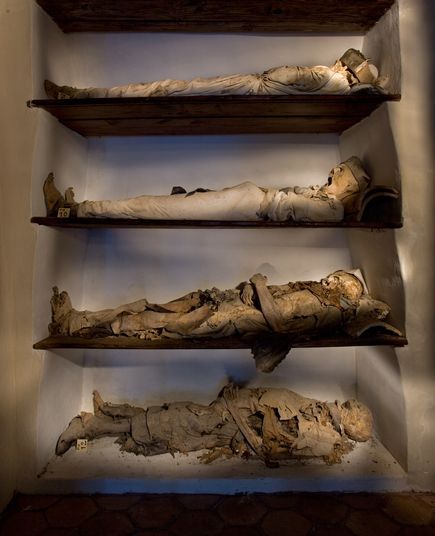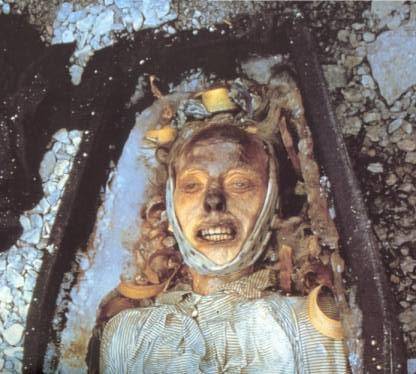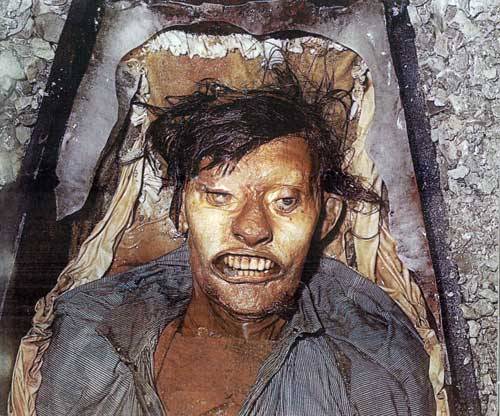#mummies
rrayed in crypts and churches, with leering skulls and parchment skin, the desiccated dead of Sicily have long kept mute vigil.
But now, centuries later, these creepy cadavers have plenty to say.
Five years into the Sicily Mummy Project, six macabre collections are offering scientists a fresh look at life and death on the Mediterranean island from the late 16th century to the mid-20th.
Led by anthropologist Dario Piombino-Mascali of the Department of Cultural Heritage and Sicilian Identity in Palermo (map), the ongoing investigation is revealing how religious men and their wealthy supporters ate, interacted, dealt with disease, and disposed of their dead.
“These mummies are a unique treasure in terms of both biology and history,” says Piombino-Mascali, who is also a National Geographic Expeditions Council grantee. (National Geographic News is part of the National Geographic Society.) “They can tell us a lot if they are studied appropriately.” (See pictures of Sicily’s mummies from National Geographic.)
Show and Tell
In the case of the Sicilian mummies, that means x-ray exams and CT scans rather than invasive sampling and autopsy. Radiographic techniques preserve the specimens—the oldest of which dates to 1599, when Capuchin friars began mummifying clergy, then nobles and bourgeoisie who hoped to secure blessed afterlives—even as they peek inside.
And what lies within?
For one thing, evidence of a good diet, says Piombino-Mascali, whose international team includes scientists from Germany, Brazil, and the United States. Since most of the mummies were well off in life, they ate a balanced mix of meat, fish, grains, vegetables, and dairy products.
But that gastronomic affluence came with a price. Radiographs of the bones also show signs of maladies like gout and skeletal disease, which Piombino-Mascali says “tended to afflict the middle and upper classes in preindustrial societies.”
And of course wealth couldn’t protect them from aging. More than two-thirds of these bodies show signs of degenerative disorders, says Piombino-Mascali—"probably because most were old adults when they died.“ (From National Geographic magazine: Sicily’s mummies offer lessons about life.)
Spilling His Guts
As work continues apace in Sicily, which operates as an autonomous region of Italy, discoveries are coming from unlikely places.
Consider the studies performed by Karl Reinhard, a forensic scientist at the University of Nebraska-Lincoln. He and his graduate students recently conducted a pilot program to see what they could glean just by examining intestines.
Their subject: "Piraino 1,” a male in his 40s who lived at the turn of the 19th century, one of 26 mummies in the Piraino Mother Church’s Sepulcher of the Priests in northeastern Sicily, which dates to the 16th century.
Radiology revealed that he had multiple myeloma, a form of cancer. But the real surprise came when Reinhard’s student Melissa Lein found evidence of milkwort, a pollen plant with antitumor agents used in China and Turkey but thought to be uncommon in Sicily.
“That indicates that people here had an esoteric knowledge of medicinal plants,” says Reinhard, whose team also found traces of grape pulp, a purgative with compounds effective in cancer treatment and cardiovascular disease. Based on the type of pulp, adds Reinhard, Piraino 1 likely died in the winter.
What’s more, Reinhard’s student Kelsey Kumm found an enormous whipworm infection—involving more than 600 worms—in the mummy’s intestinal tract. Kumm concluded that because the man had been sick with other diseases, his immune system was vulnerable to whipworm, a fecal-borne parasitic disease usually associated with poverty.
“From all these intestinal findings we can put together a pretty interesting picture,” says Reinhard. “Though this individual was well-to-do in life, one can speculate that his activities brought him into contact with the lower classes. This shows how we can create a thumbnail sketch—his disease, his diet, his time of death—from the inside of a mummy.”
Mor(t)al Quandaries
Mummification in Sicily usually meant stowing a body in a ventilated chamber, draining it of bodily fluids, and stuffing it with straw or bay leaves, to preserve its shape and combat the stink of death. Months later it would be washed with vinegar, dressed in its Sunday best, and laid in a coffin or hung on a wall.
The more recently mummified—like two-year-old Rosalia “Sleeping Beauty” Lombardo, who died of pneumonia in 1920 and lies with 1,251 others in the Capuchin Catacombs of Palermo—were embalmed with chemicals, and thus better preserved.
But for how much longer?
Piombino-Mascali is eager to perform DNA investigations on the mummies—including those at newly studied collections in the towns of Caccamo and Gangi, where wax was “peculiarly” used to create partial and complete death masks—to understand how they might be related. But with moisture, humidity, and dust preying on some of the collections, particularly those at Palermo and Piraino, time may be running out.
Piombino-Mascali says climate-control systems such as air conditioning are desperately needed, though it’s unclear if the money or political will exist to put them in place.
“We need to act fast to save these mummies,” he says. “It was the wish of these people to be mummified. So we have a moral [imperative] to preserve them.”
Whatever comes next, Piombino-Mascali says his team’s work has had an unexpectedly existential effect on the local populace.
“For many years the subject of death was taboo [in Sicily],” he says. “In the 20th century, things like the two world wars somehow influenced the approach Sicilians had toward death. They just didn’t want to talk about it anymore.
"Now, given the scientific importance of what’s emerging with these mummies, people are understanding that in Sicily, death has always been part of life. And for centuries many Sicilians were using mummification to make sure there was a constant relationship between life and death.”
Post link
In 1845, more than 100 men set sail to the New World in the hope of coming across the Northwest Passage, a legendary trade route to Asia (apparently, Lewis and Clark’s failure had only emboldened them). Lead by Sir John Franklin, They set off from Greenhithe, England in two ships, the HMS Terror and HMS Erebus, on 19 May 1845. The two ships carrying the men and their supplies never reached their destination—they were never heard from again. At least not until 1850, when a separate expedition came across what remained of a long-dead community on Beechey Island, including three mysterious graves, and in them the bodies of John Torrington, John Hartnell, and William Braine.More than 100 years later, in 1984, a team of anthropologists traveled to the region to conduct forensic tests on the bodies found in the graves on Beechey Island. After exhumation, it was discovered that all three bodies were spectacularly well-preserved, thanks in no small part to the permafrost in the tundra. So well-preserved, in fact, that the team was able to determine the probable cause of death for the men, who had died some 138 years before.As well as signs of pneumonia and tuberculosis, they learned that each of them had a lethal amount of lead in his system, probably from the ship’s water distillation system, which would have produced high lead content. The amount of lead found in their system was staggering—each man would have needed to consume 3.3 mg a day over the course of eight months to account for it.
Post link
The Detmold child
Known as the Detmold child, this 8-to-10-month-old baby died in Peru around 4480 BC – more than 3000 years before the birth of Tutankhamun. According to a recent scan (PDF) using X-ray computed tomography, the child was born with a malformed heart.
“The heart defect has caused a flooding of the lungs and has most probably led, in combination with the pulmonary infection, to the death of the young child,” according to Wilfried Rosendahl, curator of the Reiss-Engelhorn Museum in Mannheim, Germany, home to many of the mummies in the exhibition. The baby also suffered from pneumonia and turricephaly, a disease that elongates the skull.
The CT scan also revealed a small, flat, rectangular object nestled beneath the fabric around the child’s neck, assumed to be a kind of pendant, “perhaps an amulet made of bone,“ says Rosendahl.
(Image: J. Ihle/Lippisches Landesmuseum, Detmold, Germany)
Post link

ronja rövardotter moodboard





